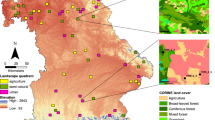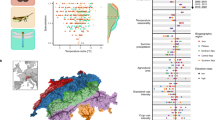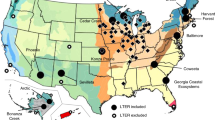Abstract
Insects have a pivotal role in ecosystem function, thus the decline of more than 75% in insect biomass in protected areas over recent decades in Central Europe1 and elsewhere2,3 has alarmed the public, pushed decision-makers4 and stimulated research on insect population trends. However, the drivers of this decline are still not well understood. Here, we reanalysed 27 years of insect biomass data from Hallmann et al.1, using sample-specific information on weather conditions during sampling and weather anomalies during the insect life cycle. This model explained variation in temporal decline in insect biomass, including an observed increase in biomass in recent years, solely on the basis of these weather variables. Our finding that terrestrial insect biomass is largely driven by complex weather conditions challenges previous assumptions that climate change is more critical in the tropics5,6 or that negative consequences in the temperate zone might only occur in the future7. Despite the recent observed increase in biomass, new combinations of unfavourable multi-annual weather conditions might be expected to further threaten insect populations under continuing climate change. Our findings also highlight the need for more climate change research on physiological mechanisms affected by annual weather conditions and anomalies.
This is a preview of subscription content, access via your institution
Access options
Access Nature and 54 other Nature Portfolio journals
Get Nature+, our best-value online-access subscription
$29.99 / 30 days
cancel any time
Subscribe to this journal
Receive 51 print issues and online access
$199.00 per year
only $3.90 per issue
Buy this article
- Purchase on Springer Link
- Instant access to full article PDF
Prices may be subject to local taxes which are calculated during checkout


Similar content being viewed by others
Data availability
Raw data for all analyses are publicly available from figshare (https://doi.org/10.6084/m9.figshare.23536551).
Code availability
Annotated R code, including the data needed to reproduce the statistical analyses and figures, is publicly available from figshare (https://doi.org/10.6084/m9.figshare.23536551).
References
Hallmann, C. A. et al. More than 75 percent decline over 27 years in total flying insect biomass in protected areas. PLoS ONE 12, e0185809 (2017).
van Klink, R. et al. Meta-analysis reveals declines in terrestrial but increases in freshwater insect abundances. Science 368, 417–420 (2020).
Seibold, S. et al. Arthropod decline in grasslands and forests is associated with drivers at landscape level. Nature 574, 671–674 (2019).
Felgentreff, E. S., Buchholz, S. & Straka, T. M. From science to society to practice? Public reactions to the insect crisis in Germany. People Nat. 5, 660–667 (2023).
Outhwaite, C. L., McCann, P. & Newbold, T. Agriculture and climate change are reshaping insect biodiversity worldwide. Nature 605, 97–102 (2022).
Deutsch, C. A. et al. Impacts of climate warming on terrestrial ectotherms across latitude. Proc. Natl Acad. Sci. USA 105, 6668–6672 (2008).
Harvey, J. A. et al. Scientists’ warning on climate change and insects. Ecol. Monogr. 93, ecm.1553 (2022).
Costanza, R. et al. The value of the world’s ecosystem services and natural capital. Nature 387, 253–260 (1997).
Barnosky, A. D. et al. Has the Earth’s sixth mass extinction already arrived? Nature 471, 51–57 (2011).
Wagner, D. L., Grames, E. M., Forister, M. L., Berenbaum, M. R. & Stopak, D. Insect decline in the Anthropocene: death by a thousand cuts. Proc. Natl Acad. Sci. USA 118, e2023989 (2021).
Pilotto, F. et al. Meta-analysis of multidecadal biodiversity trends in Europe. Nat. Commun. 11, 3486 (2020).
Uhler, J. et al. Relationship of insect biomass and richness with land use along a climate gradient. Nat. Commun. 12, 5946 (2021).
Sánchez-Bayo, F. & Wyckhuys, K. A. G. Worldwide decline of the entomofauna: a review of its drivers. Biol. Conserv. 232, 8–27 (2019).
Newell, F. L., Ausprey, I. J. & Robinson, S. K. Wet and dry extremes reduce arthropod biomass independently of leaf phenology in the wet tropics. Glob. Change Biol. 29, 308–323 (2023).
Lister, B. C. & Garcia, A. Climate-driven declines in arthropod abundance restructure a rainforest food web. Proc. Natl Acad. Sci. USA 115, E10397–E10406 (2018).
Willig, M. R. et al. Populations are not declining and food webs are not collapsing at the Luquillo Experimental Forest. Proc. Natl Acad. Sci. USA 116, 12143–12144 (2019).
Høye, T. T. et al. Nonlinear trends in abundance and diversity and complex responses to climate change in Arctic arthropods. Proc. Natl Acad. Sci. USA 118, e2002557117 (2021).
Forrest, J. R. K. Complex responses of insect phenology to climate change. Curr. Opin. Insect Sci. 17, 49–54 (2016).
Fitzgerald, J. L. et al. Abundance of spring- and winter-active arthropods declines with warming. Ecosphere 12, e03473 (2021).
Welti, E. et al. Temperature drives variation in flying insect biomass across a German Malaise trap network. Insect Conserv. Divers. 15, 168–180 (2022).
Fontrodona-Bach, A., van der Schrier, G., Melsen, L. A., Tank, A. & Teuling, A. J. Widespread and accelerated decrease of observed mean and extreme snow depth over Europe. Geophys. Res. Lett. 45, 12312–12319 (2018).
WallisDeVries, M. F., Baxter, W. & Van Vliet, A. J. H. Beyond climate envelopes: effects of weather on regional population trends in butterflies. Oecologia 167, 559–571 (2011).
Harris, J. E., Rodenhouse, N. L. & Holmes, R. T. Decline in beetle abundance and diversity in an intact temperate forest linked to climate warming. Biol. Conserv. 240, 108219 (2019).
Hodgson, J. A. et al. Predicting insect phenology across space and time. Glob. Change Biol. 17, 1289–1300 (2011).
Abarca, M. & Spahn, R. Direct and indirect effects of altered temperature regimes and phenological mismatches on insect populations. Curr. Opin. Insect Sci. 47, 67–74 (2021).
Leingärtner, A., Krauss, J. & Steffan-Dewenter, I. Elevation and experimental snowmelt manipulation affect emergence phenology and abundance of soil-hibernating arthropods. Ecol. Entomol. 39, 412–418 (2014).
Forister, M. L. et al. Impacts of a millennium drought on butterfly faunal dynamics. Clim. Change Resp. 5, 3 (2018).
Sgrò, C. M., Terblanche, J. S. & Hoffmann, A. A. What can plasticity contribute to insect responses to climate change? Annu. Rev. Entomol. 61, 433–451 (2016).
Hodges, J. S. & Reich, B. J. Adding spatially-correlated errors can mess up the fixed effect you love. Am. Stat. 64, 325–334 (2010).
Davies, G. M. & Gray, A. Don’t let spurious accusations of pseudoreplication limit our ability to learn from natural experiments (and other messy kinds of ecological monitoring). Ecol. Evol. 5, ece3.1782 (2015).
Chapman, S. C., Murphy, E. J., Stainforth, D. A. & Watkins, N. W. Trends in winter warm spells in the central England temperature record. J. Appl. Meteorol. Climatol. 59, 1069–1076 (2020).
Svenningsen, C. S. et al. Flying insect biomass is negatively associated with urban cover in surrounding landscapes. Divers. Distrib. 28, 1242–1254 (2022).
Redlich, S., Steffan-Dewenter, I., Uhler, J. & Müller, J. Hoverflies—an incomplete indicator of biodiversity. Proc. Natl Acad. Sci. USA 118, e2112619118 (2021).
Shortall, C. R. et al. Long-term changes in the abundance of flying insects. Insect Conserv. Divers. 2, 251–260 (2009).
Macgregor, C. J., Williams, J. H., Bell, J. R. & Thomas, C. D. Moth biomass increases and decreases over 50 years in Britain. Nat. Ecol. Evol. 3, 1645–1649 (2019).
Roth, N. et al. Decadal effects of landscape-wide enrichment of dead wood on saproxylic organisms in beech forests of different historic management intensity. Divers. Distrib. 25, 430–441 (2019).
Thomas, J. A. et al. Comparative losses of British butterflies, birds, and plants and the global extinction crisis. Science 303, 1879–1881 (2004).
Habel, J. C. et al. Butterfly community shifts over two centuries. Conserv. Biol. 30, 754–762 (2016).
Papanikolaou, A. D., Kühn, I., Frenzel, M. & Schweiger, O. Landscape heterogeneity enhances stability of wild bee abundance under highly varying temperature, but not under highly varying precipitation. Landsc. Ecol. 32, 581–593 (2017).
Fahrig, L. How much habitat is enough? Biol. Conserv. 100, 65–74 (2001).
Hanski, I. Metapopulation theory, its use and misuse. Basic Appl. Ecol. 5, 225–229 (2004).
Esser, G. & Overdieck, D. Modern Ecology: Basic and Applied Aspects 1st edn (Elsevier, 1991).
Halsch, C. A. et al. Insects and recent climate change. Proc. Natl Acad. Sci. USA 118, e2002543117 (2021).
Fourcade, Y. et al. Habitat amount and distribution modify community dynamics under climate change. Ecol. Lett. 24, 950–957 (2021).
Bowler, D. E., Heldbjerg, H., Fox, A. D., de Jong, M. & Bohning-Gaese, K. Long-term declines of European insectivorous bird populations and potential causes. Conserv. Biol. 33, 1120–1130 (2019).
Møller, A. P. Parallel declines in abundance of insects and insectivorous birds in Denmark over 22 years. Ecol. Evol. 9, 6581–6587 (2019).
Hallmann, C. A., Foppen, R. P. B., van Turnhout, C. A. M., de Kroon, H. & Jongejans, E. Declines in insectivorous birds are associated with high neonicotinoid concentrations. Nature 511, 341–343 (2014).
Gossner, M. M. et al. Land-use intensification causes multitrophic homogenization of grassland communities. Nature 540, 266–269 (2016).
Forister, M. L. et al. Increasing neonicotinoid use and the declining butterfly fauna of lowland California. Biol. Lett. 12, 20160475 (2016).
Owens, A. C. S. et al. Light pollution is a driver of insect declines. Biol. Conserv. 241, 108259 (2020).
Kingsolver, J. G. et al. Complex life cycles and the responses of insects to climate change. Integr. Comp. Biol. 51, 719–732 (2011).
Olsson, C. & Jönsson, A. Process-based models not always better than empirical models for simulating budburst of Norway spruce and birch in Europe. Glob. Change Biol. 20, 3492–3507 (2014).
Menzel, A., Seifert, H. & Estrella, N. Effects of recent warm and cold spells on European plant phenology. Int. J. Biometeorol. 55, 921–932 (2011).
Uhler, J. et al. A comparison of different Malaise trap types. Insect Conserv. Divers. 15, 666–672 (2022).
Busse, A. et al. Light and Malaise traps tell different stories about the spatial variations in arthropod biomass and method-specific insect abundance. Insect Conserv. Divers. 15, 655–665 (2022).
Kortmann, M. et al. Ecology versus society: impacts of bark beetle infestations on biodiversity and restorativeness in protected areas of Central Europe. Biol. Conserv. 254, 108931 (2021).
R Core Team R: A Language and Environment for Statistical Computing (R Foundation for Statistical Computing, 2022); https://www.R-project.org/.
Wood, S. N., Pya, N. & Saefken, B. Smoothing parameter and model selection for general smooth models. J. Am. Stat. Assoc. 111, 1548–1563 (2016).
Heidrich, L. et al. Heterogeneity–diversity relationships differ between and within trophic levels in temperate forests. Nat. Ecol. Evol. 4, 1431–1431 (2020).
Seibold, S. et al. The contribution of insects to global forest deadwood decomposition. Nature 597, 77–81 (2021).
Hothorn, T., Hornik, K., van de Wiel, M. A. & Zeilis, A. A Lego system for conditional inference. Am. Stat. 60, 257–263 (2006).
Acknowledgements
J.M., A.M. and Y.Y. received funding for this study from the Bavarian Ministry of Science and the Arts through the Bavarian Climate Research Network (bayklif). The collection of validation data was supported by the DFG research unit BETA-FOR supported by the German Research Foundation grant no. 459717468, the research project ‘The impact of tree mortality in Bavaria 2018–2019 on forest resilience and biodiversity’ financed by the Bavarian Ministry of the Environment and Consumer Protection, and by the project ‘Effects of silvicultural interventions on biodiversity—New methods allow new insights (L062)’ financed by the Bavarian State Ministry for Food, Agriculture and Forestry. We further acknowledge the E-OBS dataset from the EU-FP6 project Uncertainties in Ensembles of Regional Re-Analysis (http://www.uerra.eu) and the Copernicus Climate Change Service, and the data providers in the European Climate Assessment & Dataset project (https://www.ecad.eu). H. Bussler, S. Schmidt and J. Bittermann provided important suggestions during the selection of temporal windows potentially critical for insects in Malaise traps. We thank R. C. Burner and K. Vierling for linguistic correction of the manuscript.
Author information
Authors and Affiliations
Contributions
J.M. conceived the idea of this manuscript. J.M., A.M. and T.H. designed the concept of the study. Y.Y. analysed the meteorological data, J.M., T.H. and O.M. ran the final analyses. J.R., J.F., C.W. and M.W. collected validation data. J.M., A.M., S.S. and T.H. wrote the first manuscript draft and finalized the manuscript. All authors commented on the manuscript.
Corresponding author
Ethics declarations
Competing interests
The authors declare no competing interests.
Peer review
Peer review information
Nature thanks Ed Harris, Oliver Schweiger and the other, anonymous, reviewer(s) for their contribution to the peer review of this work. Peer reviewer reports are available.
Additional information
Publisher’s note Springer Nature remains neutral with regard to jurisdictional claims in published maps and institutional affiliations.
Extended data figures and tables
Extended Data Fig. 1 Map of training and validation data.
Each dot represents the location of a Malaise trap. Grey dots show location of the training data from 1989 to 2016, coloured dots show the location of the traps in the different years of the validation data. The map was created in ArcGIS Pro using the EU country layer: https://uneplivemapservices.unep.org/arcgis/rest/services/EU_Countries/MapServer (June 22, 2023).
Extended Data Fig. 2 Temporal patterns of weather anomalies during the period of 1989 to 2016.
For biomass samples from Hallmann et al.1; Spearman’s correlation coefficient for monotone associations with year is reported. Grey line shows lowess smoother and black line linear function.
Extended Data Fig. 3 Monthly climate changes in Germany for the period 1961–2020.
Climate data (temperature, precipitation, sunshine duration) are shown for the last four 30-year reference periods (1961–1990 to 1991–2020), whereby conditions in the first period (1961–1990) are taken as baseline and deviations are given either in °C (temperature) or as % (precipitation, sunshine) for the subsequent three reference periods. Data from the German Meteorological Service (https://www.dwd.de/EN/ourservices/zeitreihen/zeitreihen.html). These data show rising temperatures over the longer time period, particularly in April and during the winter.
Extended Data Fig. 4 Multiplicative change of the effects of year.
As smoothed factor in our model 5. The confidence band of the effect includes the 1. This indicates that there is no more relevant effect of year (p = 0.12; see annotated R code), once the prediction from model 5 is included as an offset.
Supplementary information
Rights and permissions
Springer Nature or its licensor (e.g. a society or other partner) holds exclusive rights to this article under a publishing agreement with the author(s) or other rightsholder(s); author self-archiving of the accepted manuscript version of this article is solely governed by the terms of such publishing agreement and applicable law.
About this article
Cite this article
Müller, J., Hothorn, T., Yuan, Y. et al. Weather explains the decline and rise of insect biomass over 34 years. Nature 628, 349–354 (2024). https://doi.org/10.1038/s41586-023-06402-z
Received:
Accepted:
Published:
Issue Date:
DOI: https://doi.org/10.1038/s41586-023-06402-z
This article is cited by
-
Do diesel exhaust particles in pollen affect colony founding in the bumble bee Bombus terrestris?
Insectes Sociaux (2024)
-
Auswirkungen der Deichmahd auf Vegetation und Arthropoden
WASSERWIRTSCHAFT (2024)
-
Earlier and more uniform spring green-up linked to lower insect richness and biomass in temperate forests
Communications Biology (2023)
Comments
By submitting a comment you agree to abide by our Terms and Community Guidelines. If you find something abusive or that does not comply with our terms or guidelines please flag it as inappropriate.



